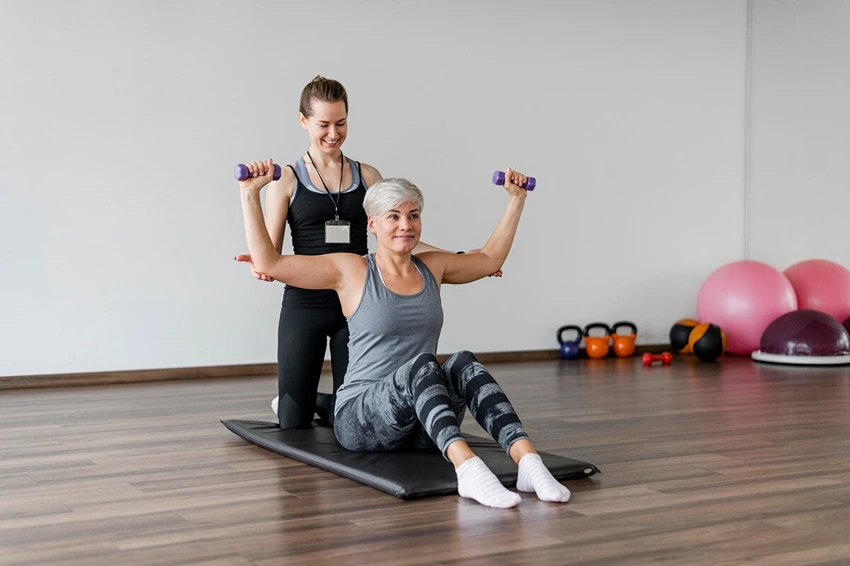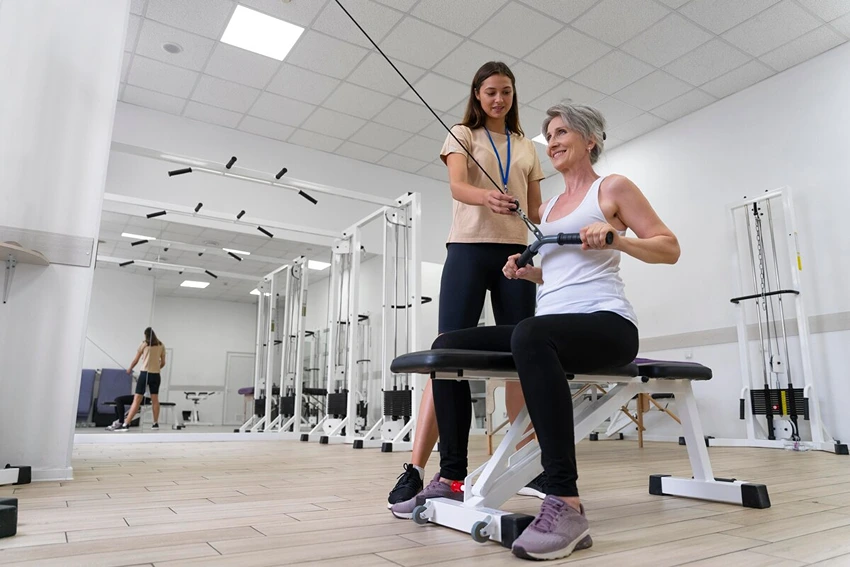As experts in women’s health and fitness, we at Rac Women understand the unique challenges and opportunities that come with strength training for senior women. Strength isn’t just for the young; it’s a vital component of healthy aging, ensuring mobility, independence, and quality of life. Here’s how you can embrace strength training, regardless of your age.
In This Article
The Science of Strength in Senior Women

Understanding Muscle Loss with Age
As we age, our bodies naturally begin to lose muscle mass, a condition known as sarcopenia. For senior women, this can lead to increased frailty and a higher risk of falls and fractures. However, with regular strength training, this muscle loss can be slowed down, or even reversed.
- Sarcopenia Prevention: Engage in strength training to slow muscle loss.
- Osteoporosis Resistance: Build bone density with weight-bearing exercises.
Hormonal Balance and Strength Training
Post-menopause, women experience a drop in estrogen levels, which can affect muscle mass and bone density. Strength training not only helps in maintaining muscle but also contributes to better hormone regulation.
- Strength Regimen: Tailor your workouts to adapt to hormonal changes.
- Senior Exercise Safety: Consult with experts to align workouts with your hormonal health.
Key Strength Training Exercises
Leg Press: Building Lower Body Strength
The leg press is a foundational exercise that targets the quadriceps, hamstrings, and glutes, crucial for maintaining lower body strength.
- Technique: Sit comfortably with feet hip-width apart, press evenly through the heels.
- Benefits: Improves balance, enhances mobility, and supports daily activities.
Chest Press: Enhancing Upper Body Power
A strong upper body is essential for daily tasks, from carrying groceries to lifting grandchildren. The chest press works the pectorals, triceps, and deltoids.
- Technique: Keep wrists straight, press the weights up without locking elbows.
- Benefits: Builds upper body strength, supports healthy posture.
Lat Pulldown: For a Strong Back
The lat pulldown is key for developing back strength, which is vital for posture and spinal health.
- Technique: Grip the bar wider than shoulder-width, pull down to the chest level.
- Benefits: Strengthens the back, reduces the risk of back pain.
Leg Curl & Abdominals: Core and Stability
Strong legs and a solid core are the cornerstones of a balanced body, especially for senior women.
- Technique: Ensure full range of motion without straining the lower back.
- Benefits: Enhances core stability, supports lower back health.

Building a Routine: Frequency and Intensity
Starting with the Basics
Begin with bodyweight exercises or light weights to build a foundation of fitness. Gradually increase intensity to challenge your muscles.
- Safe Weightlifting: Start with lighter weights, focus on form.
- Age-Defying Workouts: Incorporate a variety of exercises to target all muscle groups.
Training Frequency for Senior Women
Consistency is more important than intensity for senior women. Aim for 2-3 strength training sessions per week to see significant improvements.
- Senior Health Empowerment: Regular training can lead to enhanced independence.
- Beginner Strength Training: Start slow, build up frequency and intensity over time.
Equipment and Safety
Choosing the Right Equipment
Selecting the appropriate equipment is crucial for effective and safe workouts. Dumbbells and resistance bands are excellent choices for starting out.
- Joint-Friendly Workouts: Use equipment that doesn’t strain the joints.
- Motivational Fitness Goals: Set achievable goals to stay motivated.
Safety Tips to Prevent Injury
Proper form and technique are paramount to prevent injuries during strength training.
- Professional Guidance: Seek advice from fitness professionals to ensure safety.
- Chronic Condition Exercise: Adapt exercises to accommodate any health conditions.
Overcoming Common Challenges
Dealing with Joint Pain and Arthritis
Strength training can be adapted to be gentle on the joints while still being effective.
- Adaptive Exercises: Use low-impact exercises to minimize joint stress.
- Realistic Fitness Goals: Set sensible goals that consider joint health.
Strength Training with Chronic Conditions
Many senior women live with chronic conditions that can make exercise challenging. However, with the right approach, strength training can still be a viable option.
- Tailored Workouts: Customize exercises to work around and with chronic conditions.
- Expert Advice: Consult healthcare providers to create a safe workout plan.
Staying Motivated
Maintaining motivation can be tough, but setting small, achievable goals can help senior women stay on track with their strength training regimen.
- Community Support: Join groups or classes to build a support network.
- Track Progress: Celebrate small victories to keep spirits high.

Practical Strength Training Tips
Progressive Overload: The Path to Greater Strength
To continue making gains, it’s important to gradually increase the weight or resistance used in exercises.
- Incremental Increases: Add small amounts of weight over time to challenge your muscles.
- Consistent Challenge: Keep workouts challenging but doable to progress safely.
Incorporating Flexibility and Balance Training
Strength isn’t just about lifting weights; it’s also about having the flexibility and balance to manage those weights safely.
- Stretching: Incorporate stretching to improve flexibility and prevent injury.
- Balance Exercises: Include exercises like tai chi or yoga to enhance stability.
Nutrition: Fueling Your Strength Training
Proper nutrition is the bedrock of any fitness regimen, especially for senior women.
- Protein Intake: Ensure adequate protein to support muscle repair and growth.
- Hydration: Stay hydrated to maintain muscle function and recovery.
Frequently Asked Questions
Strength can certainly be maintained and even built upon as we age through consistent strength training and proper nutrition.
Exercises like the leg press, chest press, lat pulldown, and core workouts are highly beneficial for women over 60.
Begin with light weights or bodyweight exercises, focusing on form and safety, and gradually increase intensity as strength improves.
Ellen Crandall
Meet Ellen, your fitness compass in the world of athletics, training, and gym culture. With a commitment to well-being and a penchant for all things workout-related, Ellen is here to guide you on your journey to a healthier, fitter you. Join the fitness revolution, led by Ellen, and embrace the power of an active lifestyle.




